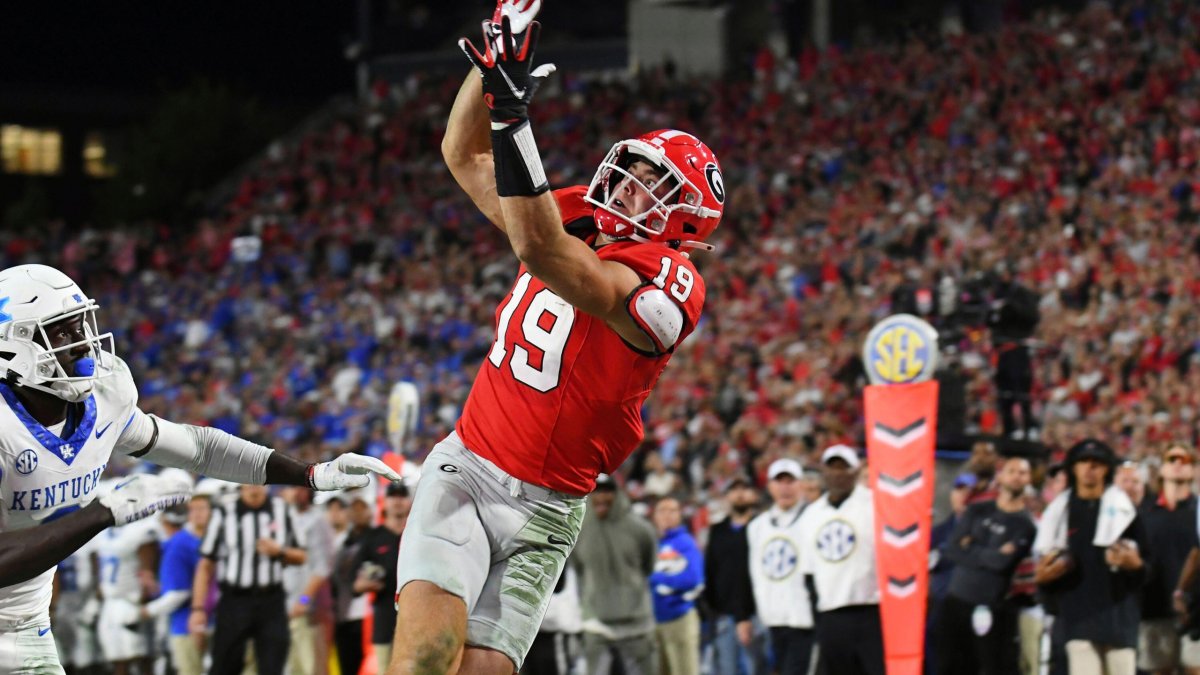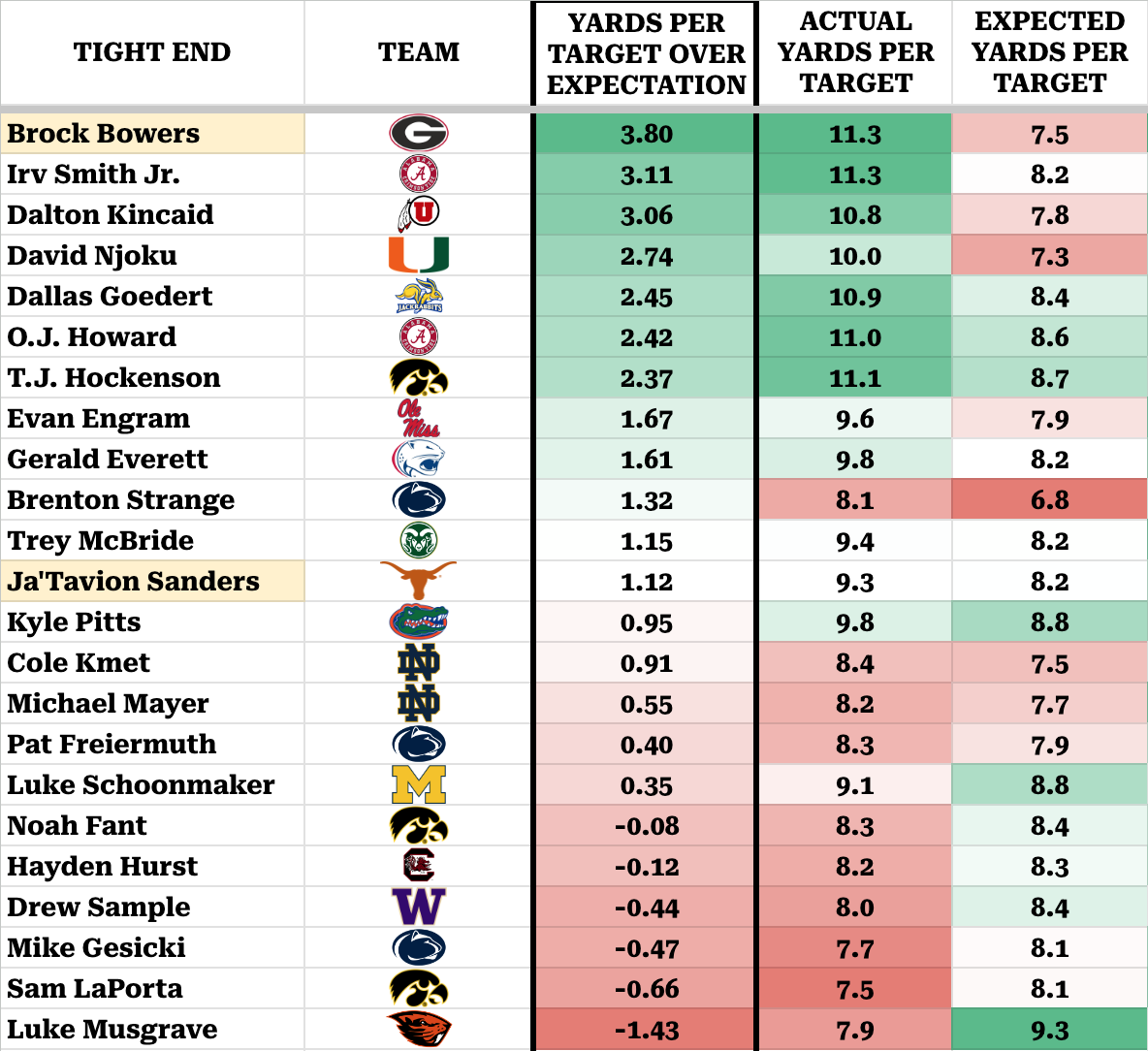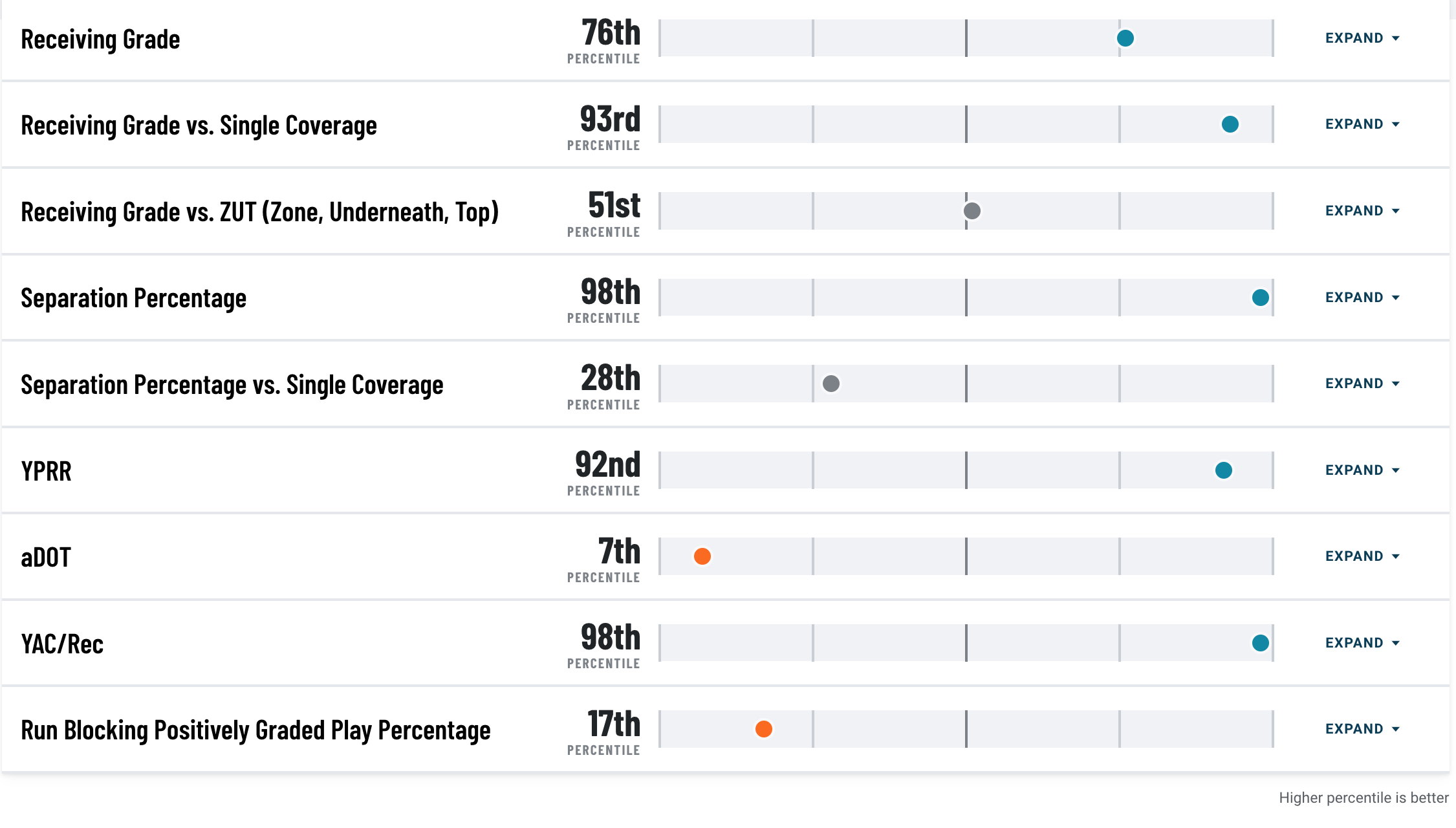Fantasy Football: Tight end rankings for the 2024 NFL Draft | NFL Draft | PFF

• No question about who No. 1 in this class is: Brock Bowers leads the way as one of the best tight end prospects in the PFF era.
• Jaheim Bell makes a case as a sleeper: Bell’s encouraging receiving metrics could allow him to greatly overcome his expected draft capital with the right landing spot and opportunity.
• Try PFF’s Mock Draft Simulator: You can trade picks and players and draft for your favorite NFL team.
Estimated Reading Time: 6 minutes
Click here for more draft tools:
2024 Mock Draft Simulator | 2024 Big Board | 2024 Draft Guide
2024 Player Profiles | 2024 Mock Drafts | NCAA Premium Stats
The NFL draft is right around the corner and with so much draft content available, it’s time to finally solidify some pre-draft fantasy rankings for this year’s class.
This year’s tight end class is highlighted by one of the top prospects at the position in recent years, but there are a few others at the position who are worthy of consideration as well. These dynasty rookie rankings will take into account each player’s college career, production profile, projected draft capital and personal bias for what I think about these players after watching their tape while combining everything else to sort them out.
Check out some of the other fantasy-related work on this year’s tight end class:
1. Brock Bowers, Georgia
The easiest ranking across all positions, Bowers is the clear-cut top tight end in this year’s class and arguably one of the best tight end prospects in recent history. The Georgia product has been a dominant force in college, posting a career 2.64 yards per route run — the best mark among all FBS tight ends taken in the first two rounds of the NFL draft since 2015. Bowers also posted the best yards per target over expectations (YPTOE) mark among all former first- and second-round tights ends, adding to his already elite profile.
Nearly regardless of the data point, Bowers ranks among the best tight end prospects of the PFF era (2014-), including first down/touchdown rate (95th percentile), yards per route run from in-line (99th percentile), wide (94th percentile) and slot (85th percentile) alignments. Bowers’ career 94.1 PFF receiving grade also ranks among the 96th percentile of prospects since 2018, as he’s primed to potentially be a top-10 pick in this year’s draft. Fantasy managers should expect immediate production regardless of landing spot, making him a valuable dynasty target in rookie drafts this year.
2. Ja’Tavion Sanders, Texas
Sanders is tracking to be a second-round pick in this year’s draft and will have potential as a strong receiving tight end who could have a path for a fantasy-relevant role as a rookie depending on his landing spot. Sanders posted a good 82.3 career PFF receiving grade (74th percentile) and career 1.81 yards per route run (72nd percentile). His production profile is nowhere near as impressive as Bowers’, but that’s also why they’re expected to be drafted so far apart. Sanders performed exceptionally well in PFF’s stable metrics for the position over the past two seasons, helping his case for translating to the NFL.
Sanders came in right around average in YPTOE when comparing to past first and second-round tight end prospects, sitting right at the line that separates a decently strong hit rate at the top and a much lower hit rate at the bottom. Excluding Bowers, eight of the 10 tight end prospects (80%) who ranked ahead of Sanders in YPTOE had at least one season as top-15 tight end in fantasy points per game. Among the 11 ranked below him, only six (54%) have hit that top-15 points per game threshold in the NFL. Sanders will be worth targeting in rookie drafts, with the more typical expectations of a rookie tight end, in that he’s less likely to be fantasy-relevant in Year 1.

3. Jaheim Bell, Florida State
This ranking might seem well off the beaten path, but Bell’s career numbers are among some of the most impressive for the tight end position in recent years. Despite currently projecting to be a Day 3 pick in the NFL draft, Bell’s athletic profile is going to be crucial in translating to the NFL, and when combined with his high-end receiving metrics, there’s a case that Bell is on par for potential long-term fantasy success as the slightly-higher-ranked Sanders.
Bell’s 2.31 career yards per route run ranks among the 89th percentile of all tight end prospects since 2018 while his 3.67 yards per route run in 2021 is the best single-season mark among all tight end prospects who ran at least 100 routes in a season (an admittedly, slightly lower threshold) over that span. While Bell did regress in yards per route run over the next two seasons, he still delivered enough to keep him in that higher range for his career, and doing so as one of the best with the ball in his hands. Bell’s career 6.90-yard average depth of target is low, but his ability to create after the catch speaks to both South Carolina and Florida State just wanting to get the ball in his hands, as he delivered a 97th percentile yards after catch per reception (9.24). Bell’s opportunity to show off his high-upside receiving ability is going to depend on his landing spot.
Jaheim Bell’s stable metrics and tight end ranks since 2021:
4. Cade Stover, Ohio State
Stover consistently improved over his time at Ohio State, culminating in a 79.4 PFF receiving grade, 41 receptions, 576 receiving yards and no drops in 2023. Stover’s 74.5 PFF receiving grade for his career ranks among the 57th percentile of all tight end prospects since 2018, and his 1.61 career yards per route run (59th percentile) isn’t that much better. In comparison to this year’s class, he fits right in this range when taking into account stable metrics and other college production numbers. He’ll have a chance to emerge as a starting tight end in the NFL with a potential upside that makes him worthy of taking a shot on later in rookie drafts.
5. Ben Sinnott, Kansas State
Sinnot’s versatility is often referenced in his draft evaluation profiles, as he’s lined up in-line (66%), in the slot (20%) and out of the backfield (13%) — but mostly because he spent so much more time out of the backfield as a full back than any other tight end in this class at 185 offensive snaps. Sinnott spent a lot of his time from that alignment as a run blocker (77%) but didn’t earn quite as strong grades as expected, ranking ninth in this class in career PFF run-blocking grade (52.0) and 12th in career PFF offensive grade from that alignment (50.9).
Sinnott does own an adequate 77.6 PFF receiving grade (64th percentile) though there might not be enough long-term upside for fantasy purposes to get too excited about. One of his red flags came when calculating these player’s yards per target over expectations (YPTOE) and Sinnott dropped in overall ranking from actual yards per target (seventh in this class) to 10th when making those adjustments since he had the highest expected yards per target, meaning favorable scenarios, and didn’t perform well enough relative to his actual outcomes.
6. Erick All, Iowa
All is one of the more difficult evaluations for this year’s class as he has a relatively low sample size in comparison to his peers, as he tore his ACL in 2023 and played just seven games with Iowa after seeing inconsistent usage during his four prior years at Michigan. Part of the lack of playing time prior to 2023 was that All underwent significant spine surgery in 2022 which kept him from playing in all but three games.
Medical and athletic question marks are plenty for All, but based on what he was able to do with his limited touches, he still makes him at least somewhat intriguing. His career YPRR (1.74) is the fifth-best mark in this class and even tied Bowers for the best target per route run rate (0.23), albeit on a much smaller scale. All also posted the sixth-best career first down and touchdown rate (9.1%) in this class, highlighting his consistency on that smaller workload. Like so many in this class, landing spot and health are going to be key in All being able to deliver as a potential fantasy starter down the road.
Related
NFL star intends to make shock return to football after…
By JAKE FENNER Published: 14:06 GMT, 8 March 2025 | Updated: 14:06 GMT, 8 March 2025 After
New York Jets Launch Year Three of NFL Girls Flag…
The New York Jets are delighted to announce the return of its highly successful Jets NFL Girls Flag league in London ahead of International Women's Day.
MOCK DRAFT WATCH: Interior OL emerges as top pick for…
Trevor Sikkema, Pro Football Focus: James Pearce Jr., Edge, Tennessee Why: Pearce had an incredibly impressive combine showing in the speed drills,
Shedeur Sanders places blame on media, says perceived drop in…
Former Colorado quarterback Shedeur Sanders opted out of throwing passes at last week's NFL Scouting Combine. He did, however, travel to Indianapolis and condu











